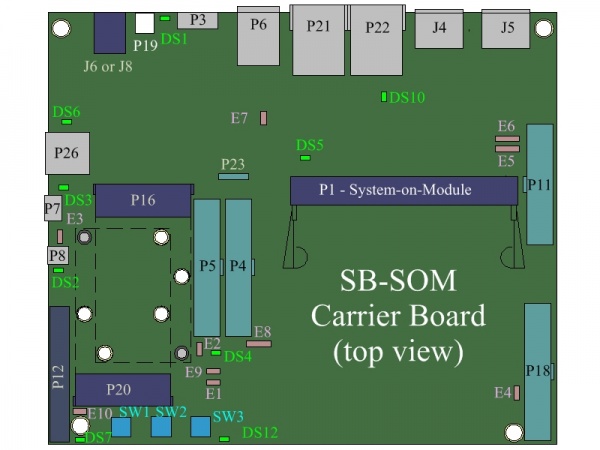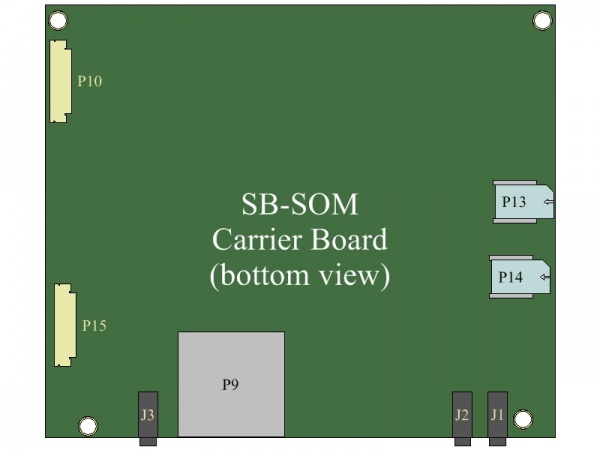CL-SOM-AM57x: Evaluation Kit: Hardware Guide
Contents
Overview
Terms and Definitions
Term Definition Evaluation kit A combination of CL-SOM-AM57x & SB-SOM boards accompanied by a set of accessories detailed here CL-SOM-AM57x A system-on-module product described here SB-SOM A generic carrier board designed to support several ARM evaluation kits from Compulab. SBC-AM57x CL-SOM-AM57x compatible SB-SOM board assembly. SoM system-on-module ACC_SBSOMCAM2ETH CL-SOM-AM57x Secondary Ethernet Adapter detailed [TBD here] Reference Carrier Board
The evaluation kit is shipped with a special assembly of the SB-SOM carrier board - SBC-AM57x.
The design materials for SB-SOM (including schematics, PCB layout and Bill of Materials) are available for download from here
Additional resources
Carrier Board
| The drawing represents a generic SB-SOM board. Some connectors might not be populated in CL-SOM-AM57x evaluation kit. |
Interfaces and Functions
Main Power
Connector J6 is the main DC power source of this evaluation kit. The DC power supply unit included with the evaluation kit provides 12V DC power to the system through J6.
More Details: Connector J6.
Serial Console
Serial console is available through one of the following interfaces:
- Serial over USB using micro-USB2.0 Type-B P7 connector. Continue to USB console guide for USB interface setup instructions.
- Serial over RS-232 using the P8 connector with custom RS-232 cable (included with the evaluation kit). Continue to RS-232 console guide for RS-232 interface setup instructions.
More Details: Connector P7, Connector P8, USB console guide, RS-232 console guide.
USB
Both CL-SOM-AM57x USB ports are accessible with this evaluation kit:
- CL-SOM-AM57x USB 3.0 Port is available through the OTG connector P3.
- USB Host connection: The micro-USB to USB type-A adapter included with evaluation kit (available for purchase here) allows usage of connector P3 as a standard USB 3.0 host port.
- USB Gadget connection: A standard micro-USB cable (included with evaluation kit) enables connection of the evaluation kit as a USB gadget to the USB port of your host computer.
- CL-SOM-AM57x USB 2.0 Port is available through one of the following connectors, depending on the state of jumper E7.
- E7 not populated: Only Dual stacked USB2.0 P6 connector and P16 mini-PCI-express connector are enabled.
- E7 populated: Only P26 USB2.0 connector is enabled.
More Details: Connector P3, Connector P6, Connector P16, Connector P26.
CAN
CAN bus nodes can be connected to evaluation kit header P5 as described in CAN node connection guide.
More Details: Connector P5, CAN node connection guide.
Ethernet
The kit features two 1Gbps copper Ethernet ports.
Primary Ethernet
The primary Ethernet port is available through RJ45 connector P21.
Secondary Ethernet
The secondary Ethernet port is available through Secondary Ethernet Adapter (ACC_SBSOMCAM2ETH), mounted on SB-SOM P18 connector.
More Details: Connector P21, Connector P18, ACC_SBSOMCAM2ETH.
Wireless
WiFi/Bluetooth
Connect both antennas (included with evaluation kit) to CL-SOM-AM57x connectors J1 and J2 for WiFi and/or Bluetooth operation.
Display
CL-SOM-AM57x evaluation platform has four video output interfaces: HDMI, LCD, DVI, and LVDS.
HDMI
The HDMI display interface is accessible through the HDMI connector J4. Default configuration of Debian Linux for CL-SOM-AM57x uses HDMI as primary video output.
LCD
Connect the LCD panel (included with evaluation kit) through the FPC connector P10:
DVI
The DVI display interface is accessible through the HDMI connector J5:
LVDS
The LVDS display interface is accessible through evaluation kit header P11. This header enables simple connection (with jumper wires) to any LVDS panel. Please refer to SB-SOM schematics for detailed information on P11.
More Details: Connector P10, Connector J4, Connector J5, Connector P11.
System
Reset
Pressing the reset button (SW2) triggers evaluation kit cold reset.
Boot Sequence Selection
Evaluation kit supports normal and alternate boot sequences. Detailed description of the sequences is available in the CL-SOM-AM57x reference guide.
- Pressing and holding the ALT.BOOT button (SW3) during power-up or cold reset forces alternative boot sequence.
- Populating the E1 jumper, constantly forces alternative boot sequence.
- Indication of selected boot sequence is shown with the DS12 LED.
Power ON / Cycle
- Pressing PWRDn button (SW1) generates a wake/power-on request.
- Pressing and holding this button results in system switch off. The key-press duration is configurable (default 10 sec).
RTC
The evaluation kit RTC (implemented onboard CL-SOM-AM57x) is powered by a coin cell battery. RTC power can be disconnected by:
- Removing the coin cell battery.
- Removing jumper E8.
To quickly discharge the RTC power, momentarily short pins 1 and 2 of jumper E8.
Multi functional signals access
Camera
TBD
UART
TBD
SPI
TBD
I2C
TBD
GPIO
TBD
Jumpers Summary
- E1 - Boot Sequence/Production.
- E2 - CL-SOM-AM57x onboard board specific data EEPROM write-protection.
- E3 - Serial console interface auto detection.
- E4 - SB-SOM board specific data EEPROM write-protection
- E5 - LVDS display connector P11 power source selection.
- E6 - LVDS display connector P11 power source selection.
- E7 - Control of USB interface accessibility through either P26 USB2.0 connector or P6, P16, and P20.
- E8 - RTC coin cell connection
More Details: Connector P11, Connector P6, Connector P16, Connector P26, Connector P20, USB console guide, RS-232 console guide.

